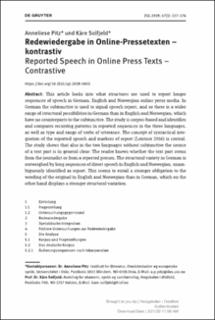| dc.contributor.author | Pitz, Anneliese Pauline | |
| dc.contributor.author | Solfjeld, Kåre | |
| dc.date.accessioned | 2020-02-21T10:23:37Z | |
| dc.date.available | 2020-02-21T10:23:37Z | |
| dc.date.created | 2019-04-12T09:43:26Z | |
| dc.date.issued | 2019-04-10 | |
| dc.identifier.citation | Zeitschrift für germanistische Linguistik. 2019, 47 (1), 137-176. | en_US |
| dc.identifier.issn | 0301-3294 | |
| dc.identifier.uri | https://hdl.handle.net/11250/2643193 | |
| dc.description.abstract | This article looks into what structures are used to report longer sequences of speech in German, English and Norwegian online press media. In German the subjunctive is used to signal speech report, and so there is a wider range of structural possibilities in German than in English and Norwegian, which have no counterparts to the subjunctive. The study is corpus-based and identifies and compares recurring patterns in reported sequences in the three languages, as well as type and range of verbs of utterance. The concept of syntactical integration of the reported speech and markers of report (Leistner 2016) is central.
The study shows that also in the two languages without subjunctive the source of a text part is in general clear: The reader knows whether the text part stems from the journalist or from a reported person. The structural variety in German is outweighed by long sequences of direct speech in English and Norwegian, unambiguously identified as report. This seems to entail a stronger obligation to the wording of the original in English and Norwegian than in German, which on the other hand displays a stronger structural variation. | en_US |
| dc.language.iso | ger | en_US |
| dc.publisher | De Gruyter | en_US |
| dc.title | Redewiedergabe in Online-Pressetexten – kontrastiv | en_US |
| dc.title.alternative | Reported speech in online press texts – contrastive | en_US |
| dc.type | Peer reviewed | en_US |
| dc.type | Journal article | en_US |
| dc.description.version | publishedVersion | en_US |
| dc.subject.nsi | VDP::Humaniora: 000::Språkvitenskapelige fag: 010 | en_US |
| dc.source.pagenumber | 137-176 | en_US |
| dc.source.volume | 47 | en_US |
| dc.source.journal | Zeitschrift für germanistische Linguistik | en_US |
| dc.source.issue | 1 | en_US |
| dc.identifier.doi | 10.1515/zgl-2019-0005 | |
| dc.identifier.cristin | 1691863 | |
| cristin.unitcode | 224,60,0,0 | |
| cristin.unitname | Avdeling for økonomi, språk og samfunnsfag | |
| cristin.ispublished | true | |
| cristin.fulltext | postprint | |
| cristin.qualitycode | 1 | |
